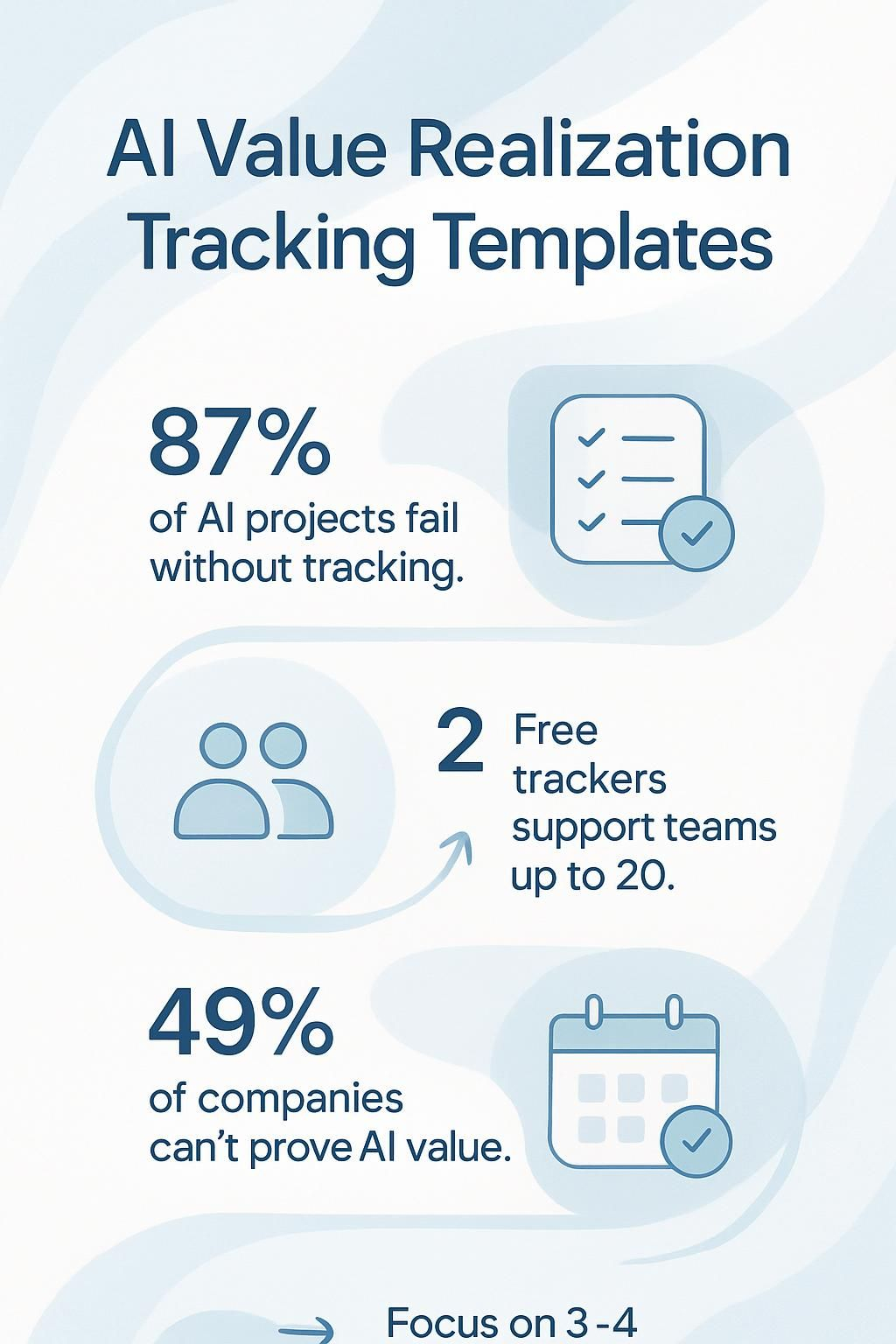AI Value Realization Tracking Templates


Understanding AI Integration

Tracking the value of AI projects feels like trying to catch smoke with your bare hands. AI value realization tracking templates offer structured frameworks to measure, monitor, and report the impact of artificial intelligence investments.
These tools transform vague promises into concrete results. The OKR framework, first introduced by Andy Grove at Intel in the 1970s and later championed by John Doerr at Google, serves as the foundation for many of these templates.
Nearly half of all companies (49%) struggle to show the real value of their AI projects. This happens mainly because they can't quantify ROI or account for all costs like hardware and staff time.
Reuben "Reu" Smith knows this challenge well. As an AI & Automation Strategist who has built over 750 workflows and generated $200M for partners, he's seen how the right tracking tools can transform business outcomes.
The problem goes deeper than just numbers. Only about 20% of organizational data exists in a structured format, making AI value measurement a major headache for tech leaders and business owners.
Cross-functional team misalignment makes things worse, with 78% of leaders experiencing what Gartner calls "collaboration drag.".
Solutions exist, but they require the right tools and processes. MeegleSolutions offers a free Feature Value Realization Tracker for small teams, while platforms like Tability can turn basic spreadsheets into dynamic OKR dashboards.
These tools help bridge the gap between AI implementation and business results. They also support continuous improvement processes vital for maintaining quality as market conditions change.
This article will show you how to pick the right templates, set up effective tracking systems, and follow best practices that turn AI investments into measurable wins. Let's fix your AI tracking problems.
Key Takeaways
- 87% of AI projects fail to deliver promised ROI due to poor tracking systems, making value realization templates essential for measuring real results.
- Free AI Value Realization Trackers from Meegle support teams up to 20 members, helping businesses connect specific AI features to measurable business outcomes.
- The OKR methodology, first used by Andy Grove at Intel in the 1970s and later adopted by Google, provides the framework for effective AI value tracking templates.
- Nearly half (49%) of companies struggle to show the actual value of their AI projects, partly because only 20% of organizational data is properly structured.
- Regular weekly reviews of AI metrics prevent project failure, with the most successful implementations focusing on just 3-4 key results per objective.

What are AI Value Realization Tracking Templates?

Now that we've covered the basics, let's dig into the tools that make AI value measurement possible.
AI Value Realization Tracking Templates function as structured frameworks that help businesses monitor the actual impact of their AI investments. These templates capture performance measurements against specific business objectives using the OKR (Objectives and Key Results) methodology.
First popularized by Andy Grove at Intel in the 1970s and later adopted by Google in the 1990s through John Doerr's influence, these tracking systems provide a common language for teams to set ambitious goals.
The templates from WorkflowGuide.com offer practical scorecards for evaluating AI features, comparing projected benefits against actual outcomes, and quantifying both tangible and intangible returns.
They transform vague impressions about AI performance into concrete data points.
AI tracking templates aren't just spreadsheets; they're the GPS for your technology investments, showing whether you're headed toward ROI or just burning fuel on a road to nowhere.
These templates solve a critical problem for tech-savvy business leaders: the gap between AI implementation and business value. MeegleSolutions offers specialized templates for tracking feature value realization that help teams assess how specific AI capabilities align with customer needs.
The best templates include sections for goal setting, progress tracking, organizational alignment, and impact analysis. Unlike generic project management tools, AI value tracking templates specifically account for machine learning performance curves, adoption metrics, and the unique ways AI creates compound value over time.
Pain Points in Tracking AI Value Realization
Tracking AI value feels like trying to catch smoke with your bare hands. Companies struggle to connect their fancy AI investments with actual business results, leaving executives scratching their heads about whether that expensive chatbot was worth the money.
Difficulty in quantifying ROI
Business leaders face a real headache when trying to measure AI's financial impact. Nearly half (49%) of companies struggle to show the actual value of their AI projects. I have seen this with clients who invest in fancy AI systems but can't explain what they got for their money.
The problem? Traditional ROI calculations fall apart with AI investments. You can't simply plug numbers into a spreadsheet and get clear answers. How do you put a dollar value on "improved customer satisfaction" or "faster decision-making"? It's like trying to measure how much your umbrella saved you during a rainstorm.
The math gets even messier when market conditions shift. Your AI solution might perform brilliantly today but struggle tomorrow as data patterns change. Plus, calculating true costs requires tracking hardware expenses, staff time, training resources, and ongoing maintenance.
Many organizations miss these hidden costs entirely. The result? Incomplete ROI calculations that don't tell the full story. This leaves tech leaders in awkward positions during budget meetings, armed with qualitative wins but lacking the hard numbers executives crave for justifying continued investment.
Lack of structured data
Organizations face a major roadblock with structured data making up only 20% of their total data pool. This creates a perfect storm for AI projects. Your company might have mountains of data, but without proper structure, your AI models lack the context they need to deliver results.
I have observed this with clients who invested heavily in AI only to watch their ROI vanish because their data resembled a junk drawer rather than an organized filing cabinet.
AI without structured data is like trying to build a house with a pile of materials but no blueprint.
The data governance gap hits hard when tracking AI value. Many businesses collect tons of unstructured data through various processes but struggle to transform it into actionable insights.
This disconnect creates a blind spot in portfolio management where teams can't effectively measure performance metrics or track their AI investments. Think of it as trying to count your calories while ignoring 80% of what you eat.
Your analytics will show progress, but the reality tells a different story.
Misalignment between teams
Team misalignment kills AI projects faster than you can say "machine learning." Cross-functional teams often speak different languages: marketing talks ROI, developers talk code, and executives talk bottom line.
This communication breakdown creates a perfect storm of confusion where 78% of leaders experience what Gartner calls "collaboration drag." I have seen companies invest millions in AI tools only to watch them gather digital dust because sales, marketing, and product teams couldn't agree on success metrics.
The costs hit hard and fast. Your sales team promises features your product team hasn't built. Your marketing team promotes benefits your AI can't deliver. Customer satisfaction plummets, revenue leaks from every crack, and that shiny AI investment looks more like a money pit.
The worst part? Most companies don't even realize this misalignment exists until they've already wasted months of work and thousands of dollars. Solutions for tracking AI value can bridge these gaps and get everyone marching toward common goals.
Want To Be In The Inner AI Circle?
We deliver great actionable content in bite sized chunks to your email. No Flim Flam just great content.

Solutions for Effective AI Value Realization Tracking
Our practical AI Value Realization Tracking solutions transform messy data into clear ROI metrics that actually make sense to both your tech team and leadership—think of them as your AI investment GPS system that prevents you from driving into the financial wilderness.
Feature Value Realization Tracker
The Feature Value Realization Tracker acts as your AI investment's report card. This powerful tool helps teams measure the actual impact of each feature they build against business goals.
Think of it like a fitness tracker for your AI projects, showing which features pull their weight and which ones just eat resources. Product managers can finally answer the dreaded question, "What did we get for all that money?" with actual data instead of nervous laughter.
Teams of up to 20 members can access this tracker for free on Meegle, making it perfect for small businesses testing AI waters. For example, a local HVAC company might track how their new AI-powered search affects customer engagement and retention rates.
The tracker connects feature performance to business outcomes through clear metrics, progress tracking, and outcome evaluation. Many product teams struggle with measuring AI value, but this solution bridges the gap between technical work and business results.
Automated OKR Dashboards offer another dimension to tracking your AI investments effectively.
Automated OKR Dashboards
Feature Value Trackers offer granular insights, but Automated OKR Dashboards take your AI value tracking to stratosphere levels. Tability transforms those clunky spreadsheets into sleek dashboards that make goal setting feel less like homework and more like mission control.
Tech leaders love how these dashboards connect daily tasks to big-picture objectives without the usual spreadsheet gymnastics.
Tability AI generates OKRs based on your prompts, saving hours of staring at blank screens wondering what metrics actually matter. Just create an account, click "Generate Goals Using AI," describe what you want to achieve, and boom, you get a fully editable template ready for tracking.
The system even offers feedback for improving your objectives or completely rewriting them if they miss the mark. For example, you might track a 20% boost in KPIs affected by your revised strategies or measure a 15% increase in value from strategic initiatives.
The days of manually updating progress reports during painful Monday meetings? Consider them extinct.
How to Get Started with AI Value Realization Templates
Starting with AI Value Realization Templates takes just three simple steps that transform how you track your AI investments and prove their worth to stakeholders - grab our free templates today to stop guessing about your AI ROI and start measuring actual business outcomes.
Sign up for a tracking tool
Getting started with AI value tracking doesn't need to be rocket science. Meegle offers a Feature Value Realization Tracker that takes the guesswork out of measuring your AI investments.
Their platform is totally free for teams up to 20 members, making it perfect for small businesses dipping their toes in the AI waters. Just click "Get this Free Template Now" on their site and you'll gain instant access to tools that transform fuzzy feelings about AI into hard data.
After registration, Meegle redirects you straight to the tracker where you can customize templates to fit your specific needs. No more spreadsheet nightmares or data scattered across twelve different platforms! The real magic happens when your team starts using it together.
The tracker enables real-time updates so everyone stays on the same page about which AI features actually move the needle for your business. I have seen teams go from "AI seems cool" to "AI saved us $43,000 last quarter" just by having the right tracking system in place.
Create and customize templates
After signing up for a tracking tool, your next step involves creating templates that match your specific AI value tracking needs. Tability AI makes this process simple with its "Generate Goals Using AI" feature.
You describe your goals in a prompt, and the system creates a fully editable OKR template ready for your team to use. The beauty lies in how quickly you can go from concept to working template without starting from scratch.
Custom templates boost your workflow by letting you build functions for content you use often. Through the "AI assistant" menu, you can manage these templates for different purposes like subtasks, test cases, or Product Requirement Documents.
This saves hours of repetitive work. Many business owners tell me they cut template creation time by 70% using this approach. Your templates should include clear objectives, measurable key results, and space for progress notes to keep everyone aligned on what success actually looks like.
Regularly monitor progress
Tracking your AI value metrics isn't a "set it and forget it" game. Weekly check-ins on your OKRs create the backbone of accountability in your organization. I have seen too many brilliant AI implementations crash and burn simply because nobody bothered to look at the numbers after launch day.
(Been there, done that, got the awkward executive meeting to prove it.) Tability's automation tools make this monitoring process less painful by automatically pulling data and visualizing trends in real-time dashboards.
No more Excel spreadsheet nightmares or hunting down metrics across seventeen different platforms.
Your monitoring schedule needs teeth. When risks appear in your dashboards, take action immediately rather than waiting for quarterly reviews. The most successful tech leaders I work with dedicate 30 minutes each Monday to review OKR progress, spot potential issues, and make quick course corrections.
This consistent rhythm keeps everyone aligned and prevents the dreaded "surprise failure" scenario at the end of a quarter. Next, let's explore the best practices that will transform your AI value tracking from a chore into a strategic advantage.
Best Practices for Using AI Value Realization Templates
Mastering AI Value Realization Templates requires both discipline and smart shortcuts - much like learning keyboard commands in your favorite game. Set up weekly template reviews with your team to catch value gaps early, and focus on three key metrics rather than tracking everything under the sun.
Set clear objectives and key results
Your AI value tracking will crash and burn without crystal-clear objectives and key results. I have watched too many business owners dump thousands into AI tools with nothing to show for it because they skipped this step.
Start by defining what business problem your AI needs to solve. Is it reducing customer service response time by 30%? Cutting order processing costs by 25%? Be specific and ambitious yet realistic.
Your key results must be measurable and time-bound, like "reduce manual data entry by 50% within 90 days." Limit yourself to 3-5 key results per objective to maintain focus. This isn't just corporate checkbox stuff, it's your roadmap to proving AI's actual worth to your bottom line.
Strategic alignment matters more than fancy tech. Your AI objectives should directly connect to your broader business goals, whether that's market expansion or operational efficiency.
I worked with a heating company that wanted AI chatbots because they sounded cool, but their real problem was lead qualification. Once we aligned their AI objective (automate initial customer qualification) with measurable results (reduce sales team time spent on non-qualified leads by 40%), their ROI skyrocketed.
Regular assessment keeps these objectives relevant as market conditions change. Think of this step as programming your GPS before a road trip, not something you figure out halfway through.
Commit to regular reviews and updates
AI value tracking only works if you stick with it. Many tech leaders launch AI projects with fanfare but skip the boring part, checking if they actually work. Data shows organizations that commit to ongoing assessments of their AI use cases adapt strategies faster and see better results.
I have seen clients waste thousands on fancy AI tools they never bothered to evaluate after launch. Think of your AI investment like a garden, not a "set it and forget it" infomercial product.
Regular checkups let you isolate and test impacts over time, helping you kill underperforming initiatives before they drain resources.
Your review schedule should sync with process engineering and change management efforts. This prevents the classic "we built it but nobody uses it" syndrome that plagues 60% of AI implementations.
Smart business owners create simple monthly scorecards for each AI project, tracking both hard metrics (cost savings, revenue) and soft benefits (employee satisfaction, time saved). These reviews help optimize resource allocation and design better incentives for adoption.
One local HVAC company I worked with tripled their ROI on an AI scheduling tool simply by implementing quarterly reviews and making small tweaks based on feedback.
Focus on actionable insights
Your AI value tracking templates should generate insights you can actually use, not just pretty charts that collect digital dust. The best templates transform raw data into clear action steps for your team.
Many business leaders waste hours reviewing dashboards packed with metrics that don't drive decisions. Instead, limit your key results to 3-4 per objective as noted in our data. This prevents team overwhelm and keeps everyone focused on what truly matters.
During your weekly OKR check-ins (yes, they should happen weekly), ask: "What specific action can we take based on this data point?" If there's no clear answer, you might be tracking the wrong things.
Data without action is just expensive decoration. Your Tability dashboards should highlight trends and risks that demand immediate attention. Think of your AI value templates as GPS navigation, not a scenic photo album of where you've been.
The SMART framework helps you set ambitious yet achievable results that lead to concrete next steps. One client described their previous reporting as "data purgatory" before switching to action-oriented templates.
The real power comes when you connect insights directly to your continuous improvement process. Let's explore how to integrate these templates into your broader AI strategy.
Integrating AI Continuous Improvement Process Design
AI systems need constant care and feeding, much like that Tamagotchi pet you probably killed back in the 90s (sorry, little digital buddy). The four-stage AI pipeline forms the backbone of any effective continuous improvement process: Data Handling gathers your raw materials, Model Learning shapes them into something useful, Software Development packages it all up, and System Operations keeps everything running smoothly.
This isn't just tech jargon, it's your roadmap to AI that actually delivers value instead of becoming another expensive digital paperweight. MLOps and CD4ML methodologies help bridge the gap between cool research ideas and solutions that actually solve real business problems.
Your continuous improvement process must include rigorous testing through CI processes, which act as the immune system for your AI deployment. Think of DevOps as the nervous system connecting everything together.
Alert systems serve as your early warning radar, flagging issues before they become catastrophic failures that have your customers flooding your inbox with angry emails. Scheduled updates maintain quality without requiring constant manual babysitting.
The goal isn't perfection on day one (that's impossible anyway), but rather creating a system that gets smarter over time through structured feedback loops and system optimization.
Local business owners often skip this step, then wonder why their fancy new AI tool stops working after a few months.
Conclusion
Tracking AI value isn't rocket science with the right templates in place. You'll save countless hours by using structured OKR dashboards that connect tech investments to real business outcomes.
Many teams struggle with vague metrics, but Feature Value Realization Trackers solve this headache by linking specific AI capabilities to measurable results. Start small with one template, customize it for your business needs, and watch as data transforms into actionable insights.
These tracking systems work best when you commit to regular reviews and focus on outcomes rather than activities. WorkflowGuide.com offers templates that bridge the gap between complex AI implementations and clear ROI measurement, making value realization accessible even for local businesses new to AI strategy.
Your AI investments deserve better than spreadsheet guesswork, so grab these templates and turn your tech spending into strategic advantage.
FAQs
1. What are AI Value Realization Tracking Templates?
AI Value Realization Tracking Templates are tools that help companies monitor the actual benefits gained from AI investments. They track metrics like cost savings, productivity gains, and revenue growth. These templates create a framework for comparing expected outcomes against real results.
2. Why should my company use AI tracking templates?
Your company can spot the gap between AI promises and reality with these templates. They help justify your tech spending by showing concrete returns. Plus, they make it easier to tweak your AI strategy when things aren't working out.
3. What key metrics should be included in AI value tracking?
Include both hard numbers like ROI and soft benefits like customer satisfaction. Track time saved, error reduction, and decision-making speed. Your template should match your specific business goals rather than using generic measurements.
4. How often should we update our AI value tracking data?
Update your tracking data monthly for fast-moving projects. This keeps everyone honest about progress without drowning in constant updates. For slower AI implementations, quarterly reviews might hit the sweet spot between oversight and practical workload.
WorkflowGuide.com is a specialized AI implementation consulting firm that transforms "AI-curious" organizations into "AI-confident" leaders through practical, business-first strategies. The firm provides hands-on implementation guidance, comprehensive readiness assessments, and actionable frameworks that align AI adoption with core business objectives. Their approach centers on principles such as Business First, Bots Second; Start Small, Fail Fast, Scale Smart; and AI Success = People Success. These insights support improved Value Realization, OKR Objectives and Key Results, and Performance Analytics for organizations of all sizes.
Disclosure: This content is informational and provided for educational purposes only. There are no sponsorships or affiliate relationships influencing this information.
Still Confused
Let's Talk for 30 Minutes
Book a no sales only answers session with a Workflow Guide
References and Citations
References
- https://www.alation.com/blog/how-to-track-ai-model-value-roi/ (2025-01-21)
- https://command.ai/blog/what-is-value-realization/ (2024-09-28)
- https://www.ttecdigital.com/articles/ai-value-realization-has-a-structured-data-problem-heres-how-to-solve-it (2025-04-28)
- https://www.thoughtworks.com/en-us/insights/blog/data-strategy/beyond-the-algorithm-overcoming-hidden-barriers-to-data-and-AI-success
- https://www.copy.ai/blog/how-ai-solves-cross-functional-misalignment-in-go-to-market
- https://www.meegle.com/en_us/advanced-templates/product_roadmapping/feature_value_realization_tracker
- https://www.researchgate.net/publication/368585108_An_AI_decision-making_framework_for_business_value_maximization
- https://www.tability.io/templates/tags/value-realization
- https://docs.storiesonboard.com/en/articles/9233771-custom-ai-templates
- https://medium.com/@adnanmasood/identifying-and-prioritizing-artificial-intelligence-use-cases-for-business-value-creation-1042af6c4f93
- https://www.gartner.com/en/documents/4429199
- https://www.sciencedirect.com/science/article/pii/S0164121223000109



